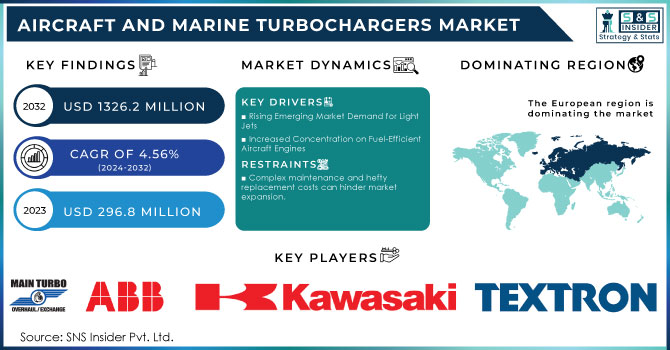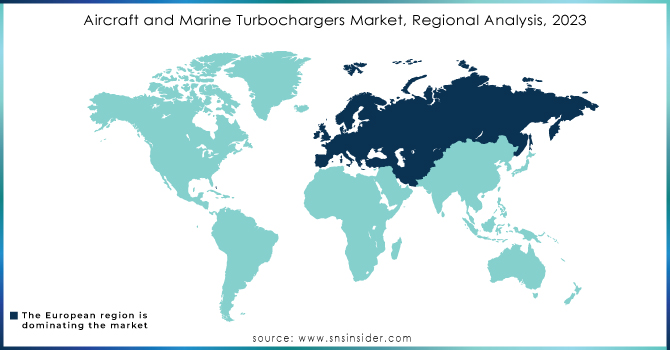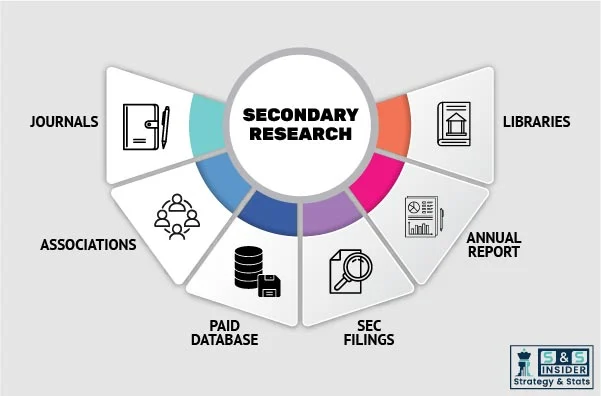
To get more information on Aircraft and Marine Turbochargers Market - Request Free Sample Report
The Aircraft and Marine Turbochargers Market Size was valued at USD 296.8 million in 2023 and is expected to reach USD 1326.2 million by 2032 with a growing CAGR of 4.56% over the forecast period 2024-2032.
Turbochargers, also known as turbine-operated forced induction devices, are used to boost the power output and efficiency of internal combustion engines in aircraft and ships (IC). It operates by forcing compressed air into the combustion chamber, improving the overall efficiency of aviation and marine engines. Turbochargers employ waste energy from the engine exhaust stream to power a turbine, which drives a compressor. This compressor pulls in ambient air, compresses it, and feeds it to the engine intake, resulting in a larger mass of air and, as a result, more fuel entering the cylinders during the intake stroke.
Furthermore, turbochargers play a significant function in all aircraft engines. When the aircraft is at a high altitude, it may experience a quick pressure drop in the ambient air. During that time, the turbochargers compress the air back to normal pressures in a fraction of a second. Furthermore, this process is known as turbo-normalization or pressure boost, which is also known as turbocharging, and it allows the engine to produce the rated power at high altitudes. As a result, this trait is critical in aeroplane mobility. Turbochargers, on the other hand, are utilised in engines of large ships and cruise ships to boost engine output capacity and power-to-weight ratio.
MARKET DYNAMICS
KEY DRIVERS
Rising Emerging Market Demand for Light Jets
Increased Concentration on Fuel-Efficient Aircraft Engines
RESTRAINTS
Complex maintenance and hefty replacement costs can hinder market expansion.
OPPORTUNITIES
3D Printing is being used to manufacture aircraft turbochargers.
Turbochargers for Marine Gasoline and Diesel Engines
CHALLENGES
Rates of Global Marine Freight
The Complex Design of Aircraft Turbochargers Leads to Difficulties in Maintenance
IMPACT OF COVID-19
Governments in major countries have declared a state of emergency because to the COVID-19 epidemic, which has caused a standstill in business. Furthermore, the lockout has had a negative impact on both the aircraft and marine industries. Because of the lockdown and travel restrictions, all aircraft were stranded at airports, significantly affecting the aviation industry. Furthermore, due to the possibility of the virus spreading, all cargo ships were stranded in the middle of the ocean and were not allowed to enter the port by authorities. The marine industry was impacted by the delayed delivery of products.
Furthermore, the pandemic interrupted all aircraft and ship manufacturing, which immediately impacted demand for aircraft and marine turbochargers. Furthermore, demand for ship and aeroplane maintenance fell during the epidemic, affecting demand for turbocharger replacement. The unavailability of workers for production and maintenance services, as well as raw materials for manufacturing, hampered the operation. Both aircraft and marine are emerging sectors that were impacted by the pandemic but are projected to recover and support the growth of the aircraft and marine turbocharger markets.
The compressor segment is likely to lead the aircraft and marine turbochargers market by component during the forecast period. Turbos often use compressor wheels, which are commonly built of aluminium alloys. However, titanium wheels machined on 5-axe mills are already being used in some commercial diesel and performance racing applications of aircraft and marine turbochargers. Despite their high cost, these wheels have been shown to reduce the number of premature failures of turbocharger components in high-boost applications in aircraft and ships.
Turboprop engines are used in ultralight (turboprop) aircraft. These engines are a more advanced variant of traditional jet engines with propellers in the engine inlets. These propellers are rotated at high speeds by engine power, which is delivered to gearboxes. Because of the enormous size of the propellers, turboprop engines are only used in applications where the aircraft flies at moderate speeds. These engines are mostly utilised in general aviation. Because turboprop engines are more fuel-efficient than typical jet engines, the market for them is expected to rise during the forecast period.
The segment held the greatest proportion of the Aircraft and Marine Turbochargers Market in 2021 and is predicted to grow at the fastest rate from 2021 to 2028. Single turbo units are commonly found in aircraft, unmanned aerial vehicles, and marine engines. This is projected to drive the segment's growth. Twin Turbocharged During the projected period of 2021 to 2028, the segment is expected to increase rapidly. The growing need for twin turbo for small planes is projected to propel this category forward.
By Component
Compressor
Turbine
Shaft
By Technology
Single Turbo
Twin Turbo
Electro-Assist Turbo
By Platform
Aircraft
Marine
REGIONAL ANALYSIS
The European region is expected to have the highest share of the aircraft and marine turbochargers market. The presence of a large number of turbocharger manufacturers in the region, such as PBS Velka Bites (the Czech Republic), Rolls-Royce (UK), and ABB (Switzerland), can be linked to the expansion of the Europe aircraft and marine turbochargers market. Furthermore, the region's severe adoption of various emission requirements in countries such as Germany, the United Kingdom, and France is increasing demand for fuel-efficient engines, which is adding to the expansion of the market for aircraft and marine turbo chargers.

Need any customization research on Aircraft and Marine Turbochargers Market - Enquiry Now
REGIONAL COVERAGE:
North America
USA
Canada
Mexico
Europe
Germany
UK
France
Italy
Spain
The Netherlands
Rest of Europe
Asia-Pacific
Japan
south Korea
China
India
Australia
Rest of Asia-Pacific
The Middle East & Africa
Israel
UAE
South Africa
Rest of Middle East & Africa
Latin America
Brazil
Argentina
Rest of Latin America
The Major Players are Main Turbo Systems, ABB, Cummins, Kawasaki Heavy Industries, MAN Energy Solutions, Textron Aviation Inc., PBS Velka Bites, Rolls-Royce, Hartzell Engine Technologies, Mitsubishi Heavy Industries, and other players
| Report Attributes | Details |
|---|---|
| Market Size in 2023 | US$ 296.8 Million |
| Market Size by 2032 | US$ 1326.2 Million |
| CAGR | CAGR of 4.56% From 2024 to 2032 |
| Base Year | 2023 |
| Forecast Period | 2024-2032 |
| Historical Data | 2020-2022 |
| Report Scope & Coverage | Market Size, Segments Analysis, Competitive Landscape, Regional Analysis, DROC & SWOT Analysis, Forecast Outlook |
| Key Segments | • By Component (Compressor, Turbine, and Shaft) • By Technology (Single Turbo, Twin Turbo, and Electro-Assist Turbo) • By Platform (Aircraft, Marine, and Unmanned Aerial Vehicle (UAV)) |
| Regional Analysis/Coverage | North America (USA, Canada, Mexico), Europe (Germany, UK, France, Italy, Spain, Netherlands, Rest of Europe), Asia-Pacific (Japan, South Korea, China, India, Australia, Rest of Asia-Pacific), The Middle East & Africa (Israel, UAE, South Africa, Rest of Middle East & Africa), Latin America (Brazil, Argentina, Rest of Latin America) |
| Company Profiles | Main Turbo Systems, ABB, Cummins, Kawasaki Heavy Industries, MAN Energy Solutions, Textron Aviation Inc., PBS Velka Bites, Rolls-Royce, Hartzell Engine Technologies, Mitsubishi Heavy Industries, and other players. |
| DRIVERS | • Rising Emerging Market Demand for Light Jets • Increased Concentration on Fuel-Efficient Aircraft Engines |
| RESTRAINTS | • Complex maintenance and hefty replacement costs can hinder market expansion. |
According to SNS insiders, the Global Aircraft and Marine Turbochargers Market size was USD 0.282 billion in 2021 and is expected to reach USD 0.312 billion by 2028 with a CAGR of 1.48% over the forecasted period.
Manufacturers/Service provider, Consultant, Association, Research institute, private and universities libraries, Suppliers and Distributors of the product.
North America, Asia-Pacific, The Middle East & Africa, Latin America,Europe are the major five region covered in this report.
Yes, the complete report mention market key player wise report.
Rising Emerging Market Demand for Light Jets and Increased Concentration on Fuel-Efficient Aircraft Engines
Table of Contents
1. Introduction
1.1 Market Definition
1.2 Scope
1.3 Research Assumptions
2. Research Methodology
3. Market Dynamics
3.1 Drivers
3.2 Restraints
3.3 Opportunities
3.4 Challenges
4. Impact Analysis
4.1 COVID-19 Impact Analysis
4.2 Impact of Ukraine- Russia War
4.3 Impact of Ongoing Recession
4.3.1 Introduction
4.3.2 Impact on major economies
4.3.2.1 US
4.3.2.2 Canada
4.3.2.3 Germany
4.3.2.4 France
4.3.2.5 United Kingdom
4.3.2.6 China
4.3.2.7 Japan
4.3.2.8 South Korea
4.3.2.9 Rest of the World
5. Value Chain Analysis
6. Porter’s 5 forces model
7. PEST Analysis
8. Aircraft and Marine Turbochargers Market Segmentation, by Component
8.1 Compressor
8.2 Turbine
8.3 Shaft
9. Aircraft and Marine Turbochargers Market Segmentation, by Technology
9.1 Single Turbo
9.2 Twin Turbo
9.3 Electro-Assist Turbo
10. Aircraft and Marine Turbochargers Market Segmentation, by Platform
10.1 Aircraft
10.2 Marine
10.3 Unmanned Aerial Vehicle
11. Regional Analysis
11.1 Introduction
11.2 North America
11.2.1 USA
11.2.2 Canada
11.2.3 Mexico
11.3 Europe
11.3.1 Germany
11.3.2 UK
11.3.3 France
11.3.4 Italy
11.3.5 Spain
11.3.6 The Netherlands
11.3.7 Rest of Europe
11.4 Asia-Pacific
11.4.1 Japan
11.4.2 South Korea
11.4.3 China
11.4.4 India
11.4.5 Australia
11.4.6 Rest of Asia-Pacific
11.5 The Middle East & Africa
11.5.1 Israel
11.5.2 UAE
11.5.3 South Africa
11.5.4 Rest
11.6 Latin America
11.6.1 Brazil
11.6.2 Argentina
11.6.3 Rest of Latin America
12. Company Profiles
12.1 Main Turbo Systems
12.1.1 Financial
12.1.2 Products/ Services Offered
12.1.3 SWOT Analysis
12.1.4 The SNS view
12.2 ABB
12.3 Cummins
12.4 Kawasaki Heavy Industries
12.5 MAN Energy Solutions
12.6 Textron Aviation Inc.
12.7 PBS Velka Bites
12.8 Rolls-Royce
12.9 Hartzell Engine Technologies
12.10 Mitsubishi Heavy Industries
13. Competitive Landscape
13.1 Competitive Benchmarking
13.2 Market Share Analysis
13.3 Recent Developments
14. Conclusion
An accurate research report requires proper strategizing as well as implementation. There are multiple factors involved in the completion of good and accurate research report and selecting the best methodology to compete the research is the toughest part. Since the research reports we provide play a crucial role in any company’s decision-making process, therefore we at SNS Insider always believe that we should choose the best method which gives us results closer to reality. This allows us to reach at a stage wherein we can provide our clients best and accurate investment to output ratio.
Each report that we prepare takes a timeframe of 350-400 business hours for production. Starting from the selection of titles through a couple of in-depth brain storming session to the final QC process before uploading our titles on our website we dedicate around 350 working hours. The titles are selected based on their current market cap and the foreseen CAGR and growth.
The 5 steps process:
Step 1: Secondary Research:
Secondary Research or Desk Research is as the name suggests is a research process wherein, we collect data through the readily available information. In this process we use various paid and unpaid databases which our team has access to and gather data through the same. This includes examining of listed companies’ annual reports, Journals, SEC filling etc. Apart from this our team has access to various associations across the globe across different industries. Lastly, we have exchange relationships with various university as well as individual libraries.

Step 2: Primary Research
When we talk about primary research, it is a type of study in which the researchers collect relevant data samples directly, rather than relying on previously collected data. This type of research is focused on gaining content specific facts that can be sued to solve specific problems. Since the collected data is fresh and first hand therefore it makes the study more accurate and genuine.
We at SNS Insider have divided Primary Research into 2 parts.
Part 1 wherein we interview the KOLs of major players as well as the upcoming ones across various geographic regions. This allows us to have their view over the market scenario and acts as an important tool to come closer to the accurate market numbers. As many as 45 paid and unpaid primary interviews are taken from both the demand and supply side of the industry to make sure we land at an accurate judgement and analysis of the market.
This step involves the triangulation of data wherein our team analyses the interview transcripts, online survey responses and observation of on filed participants. The below mentioned chart should give a better understanding of the part 1 of the primary interview.

Part 2: In this part of primary research the data collected via secondary research and the part 1 of the primary research is validated with the interviews from individual consultants and subject matter experts.
Consultants are those set of people who have at least 12 years of experience and expertise within the industry whereas Subject Matter Experts are those with at least 15 years of experience behind their back within the same space. The data with the help of two main processes i.e., FGDs (Focused Group Discussions) and IDs (Individual Discussions). This gives us a 3rd party nonbiased primary view of the market scenario making it a more dependable one while collation of the data pointers.
Step 3: Data Bank Validation
Once all the information is collected via primary and secondary sources, we run that information for data validation. At our intelligence centre our research heads track a lot of information related to the market which includes the quarterly reports, the daily stock prices, and other relevant information. Our data bank server gets updated every fortnight and that is how the information which we collected using our primary and secondary information is revalidated in real time.

Step 4: QA/QC Process
After all the data collection and validation our team does a final level of quality check and quality assurance to get rid of any unwanted or undesired mistakes. This might include but not limited to getting rid of the any typos, duplication of numbers or missing of any important information. The people involved in this process include technical content writers, research heads and graphics people. Once this process is completed the title gets uploader on our platform for our clients to read it.
Step 5: Final QC/QA Process:
This is the last process and comes when the client has ordered the study. In this process a final QA/QC is done before the study is emailed to the client. Since we believe in giving our clients a good experience of our research studies, therefore, to make sure that we do not lack at our end in any way humanly possible we do a final round of quality check and then dispatch the study to the client.